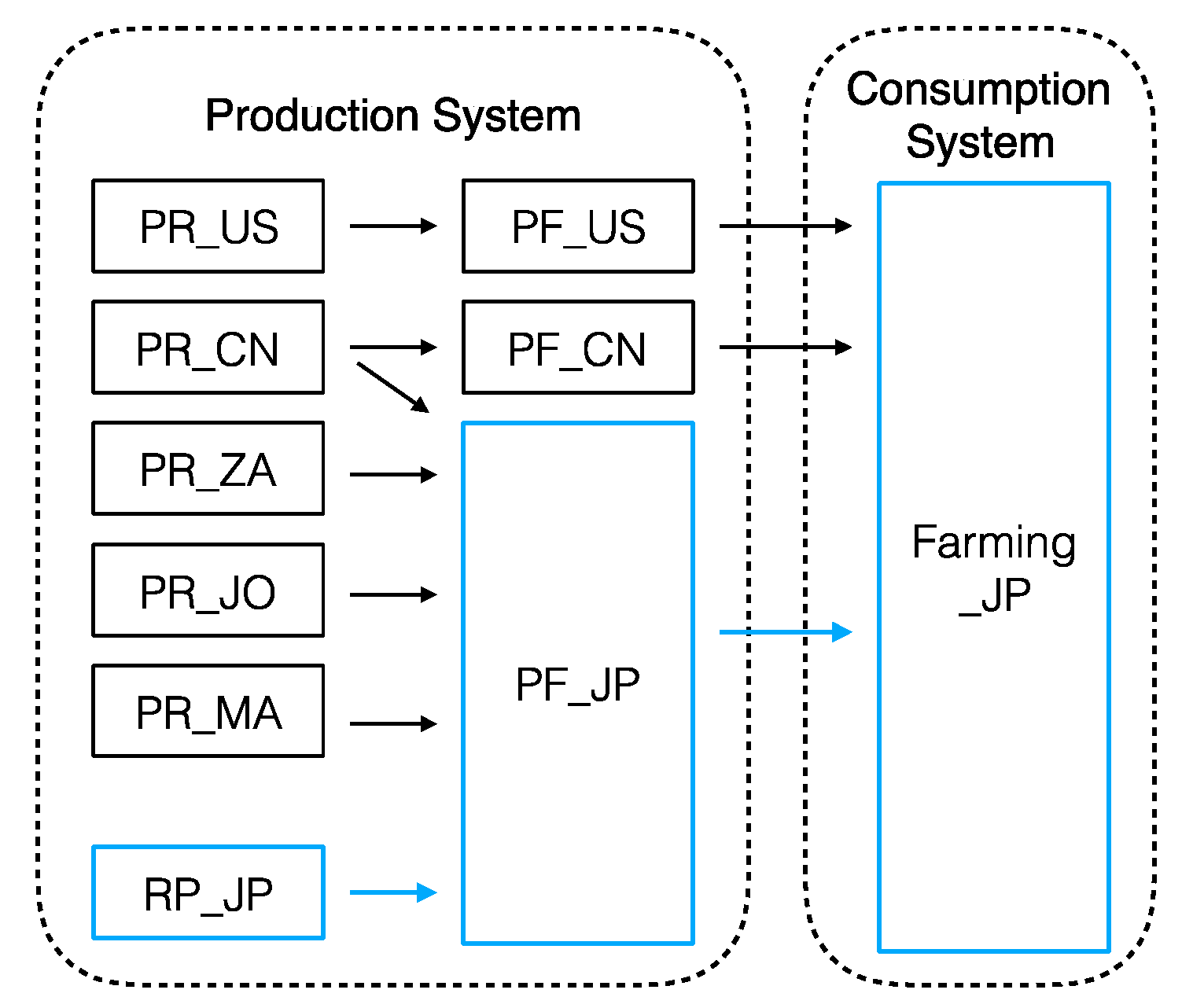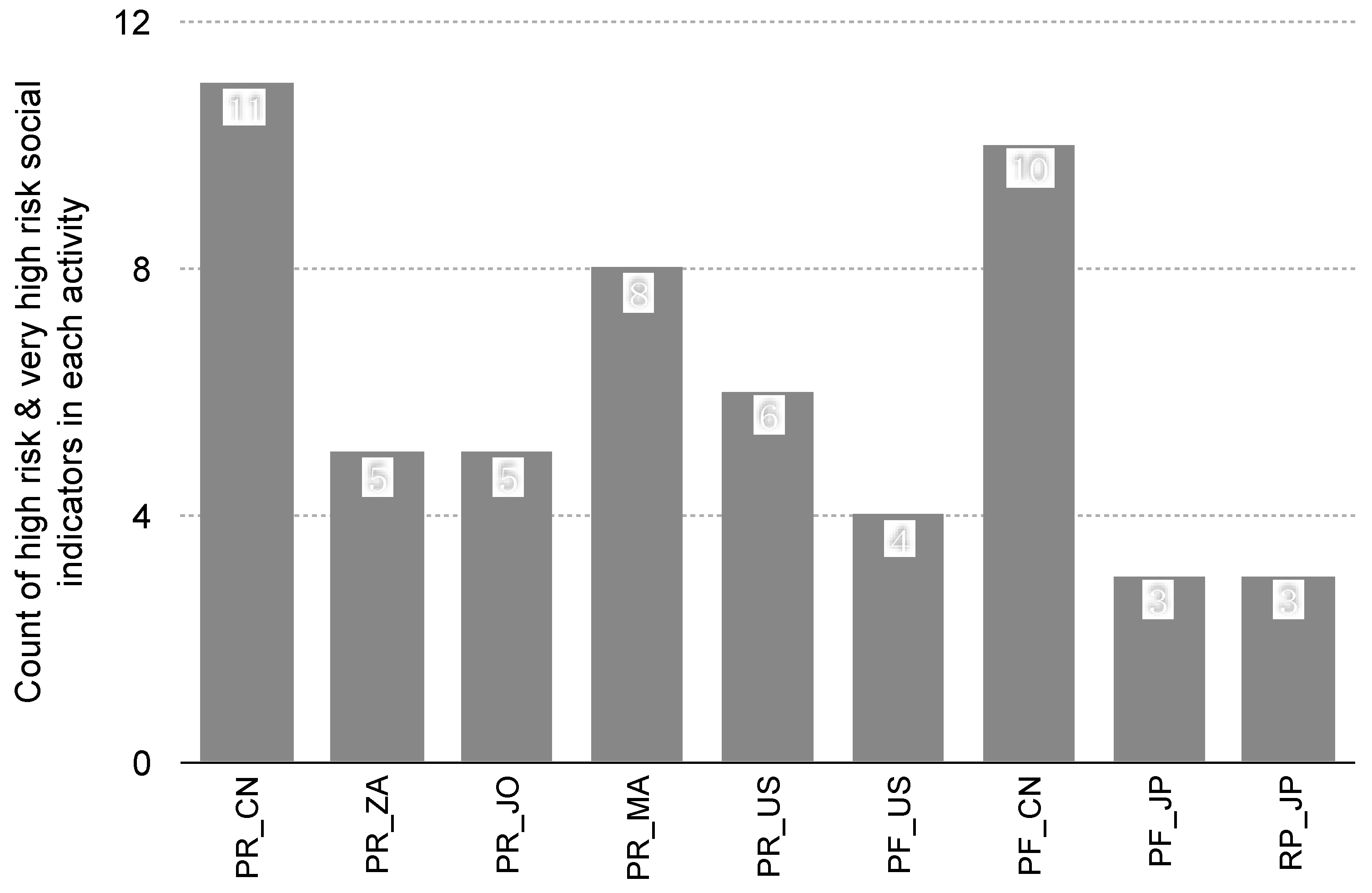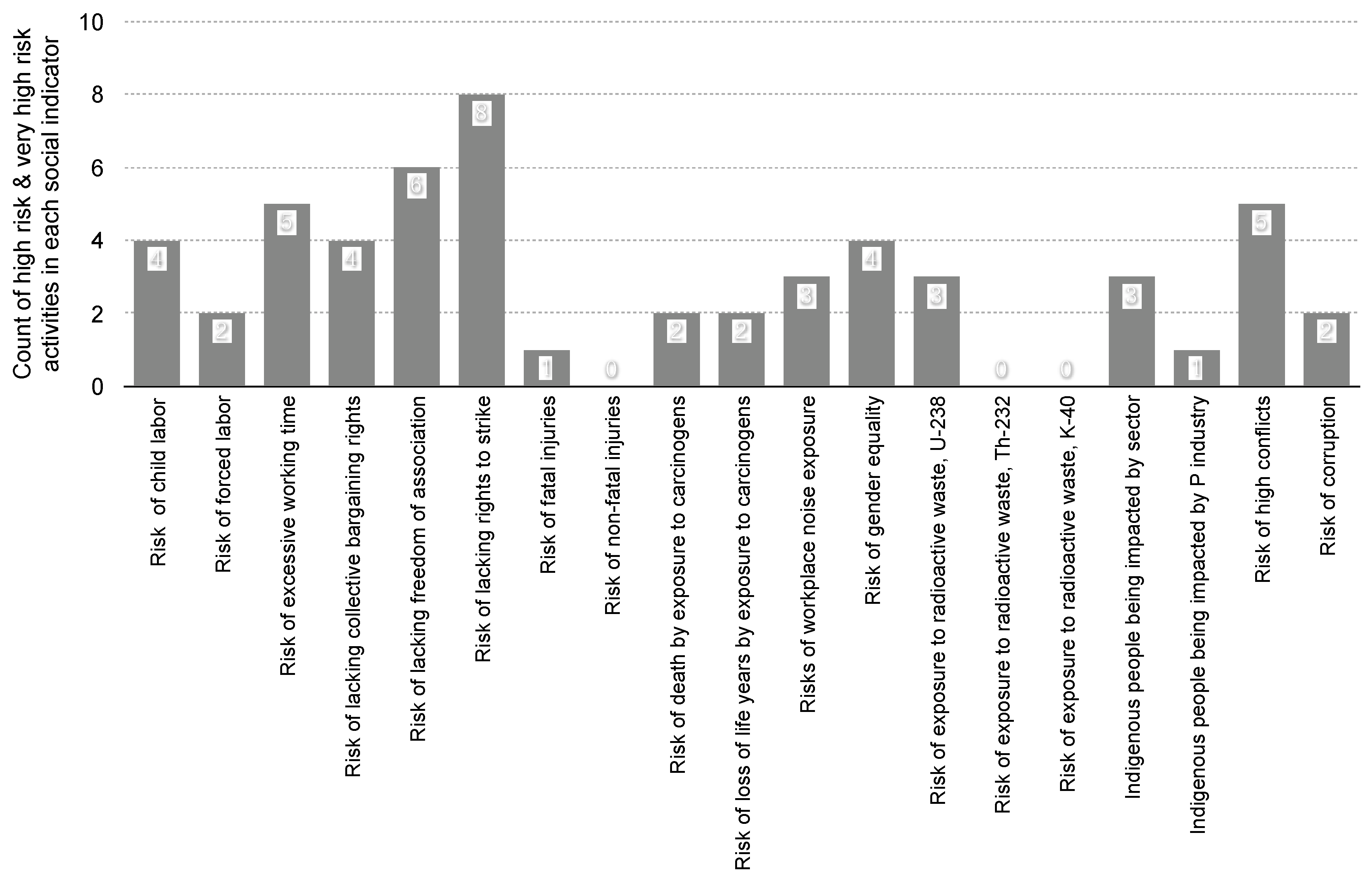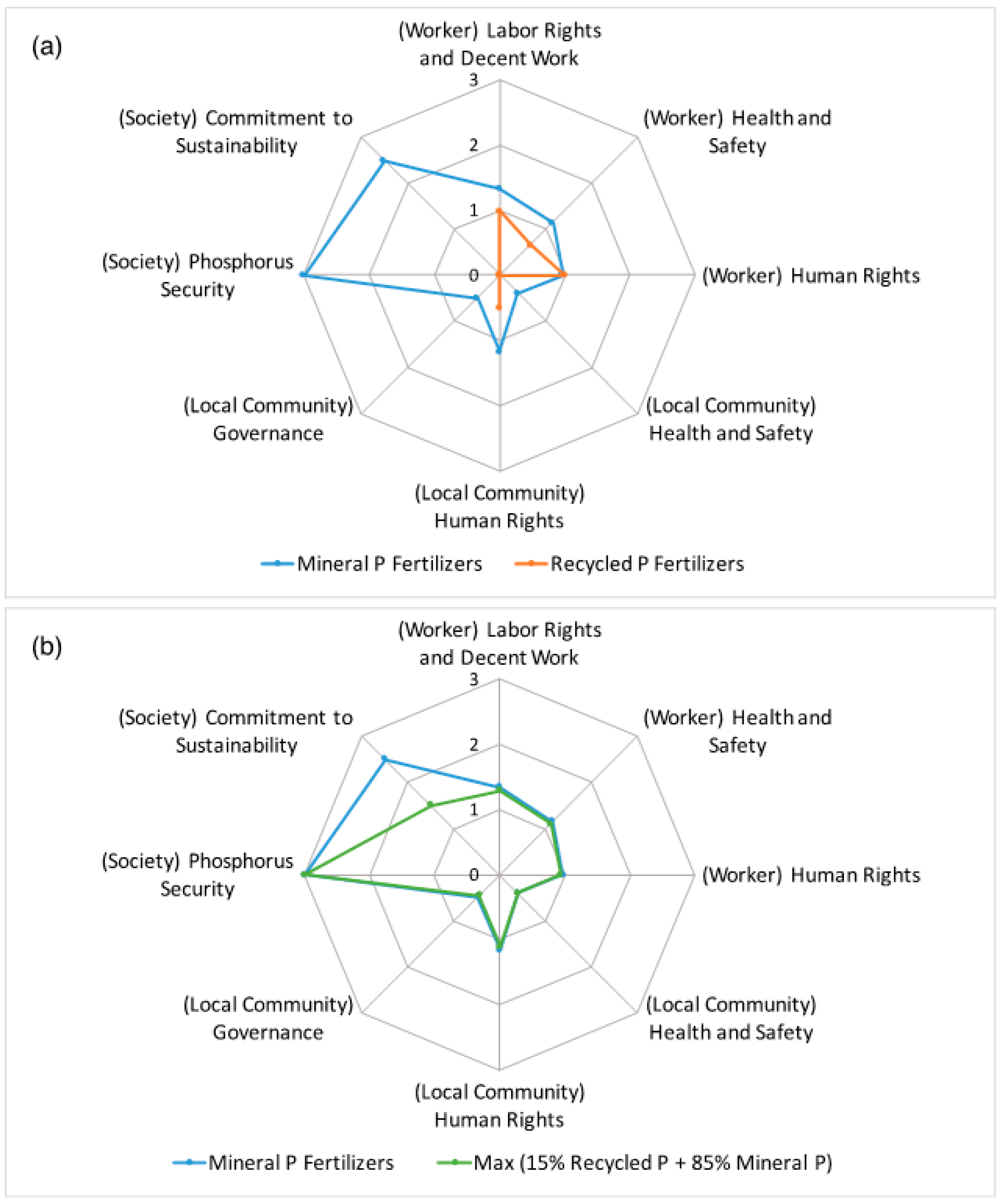Support Phosphorus Recycling Policy with Social Life Cycle Assessment: A Case of Japan
Abstract
:1. Introduction
- Human rights: Not all P is mined rightfully. Morocco, the largest P reserve country, for example, is illegally occupying the Western Sahara to acquire a large deposit of high-quality P ores [9,10]. Consequently, the indigenous Saharawi people have been forced out and resettled in refugee camps in Algeria [11].
- Health and safety: P contains naturally occurring radioactive materials (NORM) [12,13]. NORMs are especially concentrated in the by-product or waste of fertilizer production [14]. A lack of effective waste management and monitoring systems poses radioactive health risks to the local and associated communities [15,16].
- Livelihood: P price fluctuations in the international market affects the farmer’s livelihood. In 2008, the P rock price spiked to as high as 800% of the price of the previous year, according to the World Bank. Thus, many farmers’ quality of life were affected and contributed to extreme events such as farmer riots and suicides [9].
- Resource security: P rocks are defined as critical resources based on the supply risk and economic importance under the EU framework [17]. As P mineral supply is concentrated only in a few countries, the P import-dependent countries are vulnerable to their foreign policy. In the 2008 event, the global P supply was disrupted due to the sudden tariff increase of P rock exports imposed by the Chinese Government [9].
- Equity: Nykvist et al. and UN Food and Agriculture Organization statistics [18] showed that countries around the world varied greatly in the use of P in terms of per capita in the nation, and in per hectare farmland input. Considering the scarcity of P, we risk the long-term availability of the resource, and equal rights to accessing P for less advantaged communities.
2. Materials and Methods
2.1. Goal and Scope Definition
2.2. Inventory
2.2.1. Social Impact Indicators
2.2.2. Activity Coefficient
2.3. Impact Assessment and Interpretation
2.3.1. Social Impacts Hotspots
2.3.2. Comparisons of Mineral and Recycled-Based P Fertilizers
- (a)
- We compared the social impacts on stakeholders while consuming mineral and recycled-based P fertilizers in general. We assumed that the impacts for mineral P fertilizers were based on the average of import sources and production processes, and recycled P fertilizers were based on a single source and production process only, which was Japan. Therefore, the assessment showed the marginal social impact that could be mitigated by changing the choices of P fertilizers for individual farmers in Japan.
- (b)
- We conducted another comparison to show the social impact mitigation potential if Japan maximized the local P recycling from WWTP and substituted the P rock imports accordingly. The capacity of recycled P fertilizer production was constrained by the total available P collected in the WWTP. We based the assessment on a P material flow analysis study in 2009 [35]. The estimation for P in the wastewater sector was based on population, and since the population of Japan has been mostly stagnant for the past 20 years, we estimated a total of 52,750 metric tons of recycled P was available without considering the losses in the production processes, which could substitute 15% of P rock imports. We assumed that total P fertilizer consumption was the same, and the maximum recycled P substituted the P rock imports from the highest social impacts source, i.e., China in this case. Furthermore, the activity coefficient was adjusted accordingly. This second comparison showed the maximum achievable social impact mitigation from implementing a compulsory P recycling policy at the nation (or country) scale by the Japanese Government.
3. Results
3.1. Inventory Results
3.2. Social Impacts Hotspots
3.3. Comparisons of Mineral and Recycled-Based P Fertilizers
4. Discussion
4.1. Limitations
4.2. Alternative Frameworks for Supporting P Recycling Policy
5. Conclusions
Supplementary Materials
Acknowledgments
Author Contributions
Conflict of Interest
Abbreviation
| P | Phosphorus |
| WWTP | Wastewater treatment plant |
| SLCA | Social Life Cycle Assessment |
| UNEP-SETAC | United Nations Environment Program & Society of Environmental Toxicology and Chemistry |
| NORM | Naturally occurring radioactive materials |
| SHDB | Social Hotspots Database |
| MAP | Magnesium ammonium phosphate, or struvite |
| HAP | Hydroxyapatite |
References
- Cordell, D.; Drangert, J.O.; White, S. The story of phosphorus: Global food security and food for thought. Glob. Environ. Chang. 2009, 19, 292–305. [Google Scholar] [CrossRef]
- Le Corre, K.S.; Valsami-Jones, E.; Hobbs, P.; Parsons, S.A. Phosphorus recovery from wastewater by struvite crystallization: A review. Crit. Rev. Environ. Sci. Technol. 2009, 39, 433–477. [Google Scholar] [CrossRef]
- Adam, C.; Peplinski, B.; Michaelis, M.; Kley, G.; Simon, F.-G. Thermochemical treatment of sewage sludge ashes for phosphorus recovery. Waste Manag. 2009, 29, 1122–1128. [Google Scholar] [CrossRef] [PubMed]
- Linderholm, K.; Tillman, A.-M.; Mattsson, J.E. Life cycle assessment of phosphorus alternatives for Swedish agriculture. Resour. Conser. Recycl. 2012, 66, 27–39. [Google Scholar] [CrossRef]
- Hong, J.; Hong, J.; Otaki, M.; Jolliet, O. Environmental and economic life cycle assessment for sewage sludge treatment processes in Japan. Waste Manag. 2009, 29, 696–703. [Google Scholar] [CrossRef] [PubMed]
- Johansson, K.; Perzon, M.; Froling, M.; Mossakowska, A.; Svanstrom, M. Sewage sludge handling with phosphorus utilization—Life cycle assessment of four alternatives. J. Clean. Prod. 2008, 16, 135–151. [Google Scholar] [CrossRef]
- Kalmykova, Y.; Karlfeldt Fedje, K. Phosphorus recovery from municipal solid waste incineration fly ash. Waste Manag. 2013, 33, 1403–1410. [Google Scholar] [CrossRef] [PubMed]
- Martínez-Blanco, J.; Lehmann, A.; Muñoz, P.; Antón, A.; Traverso, M.; Rieradevall, J.; Finkbeiner, M. Application challenges for the social Life Cycle Assessment of fertilizers within life cycle sustainability assessment. J. Clean. Prod. 2014, 69, 34–48. [Google Scholar] [CrossRef]
- Cordell, D.; Turner, A.; Chong, J. The hidden cost of phosphate fertilizers: mapping multi-stakeholder supply chain risks and impacts from mine to fork. Glob. Chang. Peace Secur. 2015, 27, 323–343. [Google Scholar] [CrossRef]
- Smith, J.J. The taking of the Sahara: the role of natural resources in the continuing occupation of Western Sahara. Glob. Chang. Peace Secur. 2015, 27, 263–284. [Google Scholar] [CrossRef]
- Hagen, E. Saharawi conflict phosphates and the Australian dinner table. Glob. Chang. Peace Secur. 2015, 27, 377–393. [Google Scholar] [CrossRef]
- Azouazi, M.; Ouahidi, Y.; Fakhi, S.; Andres, Y.; Abbe, J.C.; Benmansour, M. Natural radioactivity in phosphates, phosphogypsum and natural waters in Morocco. J. Environ. Radioactiv. 2001, 54, 231–242. [Google Scholar] [CrossRef]
- Fávaro, D. Natural radioactivity in phosphate rock, phosphogypsum and phosphate fertilizers in Brazil. J. Radioanal. Nucl. Chem. 2005, 264, 445–448. [Google Scholar] [CrossRef]
- United Nations Environment Programme (UNEP); International Fertilizer Industry Association. Environmental Aspects of Phosphate and Potash Mining; United Nations Environment Programme (UNEP); International Fertilizer Industry Association: Paris, France, 2001. [Google Scholar]
- Papastefanou, C.; Stoulos, S.; Ioannidou, A.; Manolopoulou, M. The application of phosphogypsum in agriculture and the radiological impact. J. Environ. Radioactiv. 2006, 89, 188–198. [Google Scholar] [CrossRef] [PubMed]
- Tayibi, H.; Choura, M.; López, F.A.; Alguacil, F.J.; López-Delgado, A. Environmental impact and management of phosphogypsum. J. Environ. Manag. 2009, 90, 2377–2386. [Google Scholar] [CrossRef] [PubMed]
- EU Ad-Hoc Working Group on Raw Materials. Report on Critical Raw Materials for the EU; European Commission: Brussels, Belgium, 2014. [Google Scholar]
- Nykvist, B.; Persson, A.; Moberg, F.; Persson, L.; Cornell, S.; Rockström, J. National Environmental Performance on Planetary Boundaries; Swedish Environmental Protection Agency: Stockholm, Sweden, 2013. [Google Scholar]
- United Nations Environment Programme (UNEP); Society for Environmental Toxicology and Chemistry (SETAC). Guidelines for Social Life Cycle Assessment of Products; United Nations Environment Programme (UNEP); Society for Environmental Toxicology and Chemistry (SETAC): Nairobi, Kenya, 2009. [Google Scholar]
- Fan, Y.; Wu, R.Q.; Chen, J.Q.; Apul, D. A Review of Social Life Cycle Assessment Methodologies. In Social Life Cycle Assessment; Springer: Singapore, 2015; pp. 1–23. [Google Scholar]
- Chhipi-Shrestha, G.K.; Hewage, K.; Sadiq, R. ‘Socializing’ sustainability: A critical review on current development status of social life cycle impact assessment method. Clean. Technol. Environ. 2015, 17, 579–596. [Google Scholar] [CrossRef]
- Wu, R.Q.; Yang, D.; Chen, J.Q. Social Life Cycle Assessment Revisited. Sustainability 2014, 6, 4200–4226. [Google Scholar] [CrossRef]
- Parent, J.; Cucuzzella, C.; Revéret, J.-P. Impact assessment in SLCA: Sorting the sLCIA methods according to their outcomes. Int. J. LCA 2010, 15, 164–171. [Google Scholar] [CrossRef]
- Jorgensen, A.; Le Bocq, A.; Nazarkina, L.; Hauschild, M. Methodologies for social life cycle assessment. Int. J. Life Cycle Ass. 2008, 13, 96–103. [Google Scholar] [CrossRef]
- Weidema, B.P. The integration of economic and social aspects in life cycle impact assessment. Int. J. LCA 2006, 11, 89–96. [Google Scholar] [CrossRef]
- Norris, G.A. Social impacts in product life cycles-Towards life cycle attribute assessment. Int. J. LCA 2006, 11, 97–104. [Google Scholar] [CrossRef]
- Dreyer, L.; Hauschild, M.; Schierbeck, J. A Framework for Social Life Cycle Impact Assessment (10 pp). Int. J. LCA 2006, 11, 88–97. [Google Scholar] [CrossRef]
- Ekener-Petersen, E.; Moberg, Å. Potential hotspots identified by social LCA–Part 2: Reflections on a study of a complex product. Int. J. LCA 2013, 18, 144–154. [Google Scholar] [CrossRef]
- Ekener-Petersen, E.; Finnveden, G. Potential hotspots identified by social LCA—Part 1: A case study of a laptop computer. Int. J. LCA 2013, 18, 127–143. [Google Scholar] [CrossRef]
- Manik, Y.; Leahy, J.; Halog, A. Social life cycle assessment of palm oil biodiesel: A case study in Jambi Province of Indonesia. Int. J. LCA 2013, 18, 1386–1392. [Google Scholar] [CrossRef]
- GreenDelta PSILCA: Understanding Social Impact. Available online: http://www.psilca.net/ (accessed on 13 June 2017).
- Sala, S.; Vasta, A.; Mancini, L.; Dewulf, J.; Rosenbaum, E. Social Life Cycle Assessment: State of the Art and Challenges for Supporting Product Policies; European Commission: Brussels, Belgium, 2015. [Google Scholar]
- Ekener-Petersen, E.; Höglund, J.; Finnveden, G. Screening potential social impacts of fossil fuels and biofuels for vehicles. Energy Policy 2014, 73, 416–426. [Google Scholar] [CrossRef]
- Cordell, D.; Rosemarin, A.; Schroder, J.J.; Smit, A.L. Towards global phosphorus security: A systems framework for phosphorus recovery and reuse options. Chemosphere 2011, 84, 747–758. [Google Scholar] [CrossRef] [PubMed]
- Matsubae-Yokoyama, K.; Kubo, H.; Nakajima, K.; Nagasaka, T. A Material Flow Analysis of Phosphorus in Japan. J. Ind. Ecol. 2009, 13, 687–705. [Google Scholar] [CrossRef]
- Matsubae, K.; Kajiyama, J.; Hiraki, T.; Nagasaka, T. Virtual phosphorus ore requirement of Japanese economy. Chemosphere 2011, 84, 767–772. [Google Scholar] [CrossRef] [PubMed]
- Ohtake, H.; Okano, K. Development and Implementation of Technologies for Recycling Phosphorus in Secondary Resources in Japan. Glob. Environ. Res. 2015, 19, 49–65. [Google Scholar]
- Matsubae, K.; Webeck, E.; Nansai, K.; Nakajima, K.; Tanaka, M.; Nagasaka, T. Hidden phosphorus flows related with non-agriculture industrial activities: A focus on steelmaking and metal surface treatment. Resour. Conser. Recycl. 2015, 105, 360–367. [Google Scholar] [CrossRef]
- A Literature Review of Type I SLCA—Making the Logic Underlying Methodological Choices Explicit. Available online : https://link.springer.com/article/10.1007/s11367-016-1067-z (accessed on 12 July 2017).
- Cordell, D.; White, S. Tracking phosphorus security: indicators of phosphorus vulnerability in the global food system. Food Sec. 2015, 7, 337–350. [Google Scholar] [CrossRef]
- Benoit-Norris, C.; Cavan, D.A.; Norris, G. Identifying Social Impacts in Product Supply Chains: Overview and Application of the Social Hotspot Database. Sustainability 2012, 4, 1946–1965. [Google Scholar] [CrossRef]
- Kruse, S.A.; Flysjö, A.; Kasperczyk, N.; Scholz, A.J. Socioeconomic indicators as a complement to life cycle assessment—An application to salmon production systems. Int. J. LCA 2009, 14, 8–18. [Google Scholar] [CrossRef]
- Benoít Norris, C.; Norris, G.A.; Aulisio Caven, D. Socil Hotspots Database—Supporting Documentation; European Commission: Brussels, Belgium, 2015. [Google Scholar]
- Benoit, C.; Norris, G.A.; Valdivia, S.; Ciroth, A.; Moberg, A.; Bos, U.; Prakash, S.; Ugaya, C.; Beck, T. The guidelines for social life cycle assessment of products: Just in time! Int. J. Life Cycle Assess. 2010, 15, 156–163. [Google Scholar] [CrossRef]
- National Instutute of Radiological Sciences. NORM Database. Available online: http://www.nirs.qst.go.jp/db/anzendb/NORMDB/ENG/1_bussitunokensaku.php (accessed on 31 May 2017).
- Ministry of the Environment (Japan), Sound Material-Cycle Society. Available online: http://www.env.go.jp/en/recycle/smcs/index.html (accessed on 4 July 2017).
- Geissler, B.; Mew, M.C.; Weber, O.; Steiner, G. Efficiency performance of the world’s leading corporations in phosphate rock mining. Resour. Conser. Recycl. 2015, 105, 246–258. [Google Scholar] [CrossRef]
- International Trade Union Confederation. Annual Survey of Violations of Trande Union Rights. Available online: https://www.ituc-csi.org/annual-survey-of-violations-of,271 (accessed on 5 May 2017).
- Heidelberg Institute for International Conflict Research, Conflict Barometer. 2016. Available online: https://www.hiik.de/en/konfliktbarometer/ (accessed on 31 May 2017).
- Cordell, D.; Neset, T.-S.S. Phosphorus vulnerability: A qualitative framework for assessing the vulnerability of national and regional food systems to the multi-dimensional stressors of phosphorus scarcity. Glob. Environ. Chang. 2014, 24, 108–122. [Google Scholar] [CrossRef]
- Cordell, D.; White, S. Peak phosphorus: clarifying the key issues of a vigorous debate about long-term phosphorus security. Sustainability 2011, 3, 2027–2049. [Google Scholar] [CrossRef]
- Jorgensen, A.; Dreyer, L.C.; Wangel, A. Addressing the effect of social life cycle assessments. Int. J. Life Cycle Assess. 2012, 17, 828–839. [Google Scholar] [CrossRef]




| Activities | Stakeholders (in Respective Countries) | Social Impact Categories |
|---|---|---|
| Production System: Mining, fertilizer production, WWTP operation | Workers | Labor rights and decent work, health and safety, human rights |
| Local communities | Health and safety, human rights, governance | |
| Consumption System: Farming | Farmers | Livelihood |
| Society | P security, commitment to sustainability issues |
| Categories | Social Themes | Selected Descriptive Specific Indicators | Reasons for Inclusion |
|---|---|---|---|
| Health and safety of local communities | Exposure to NORMs | Bq/kg U-238 series in P rock | U-238 series, Th-232 series, and K-40 are the types of naturally occurring radionuclide [45]. Natural P rocks in normal condition include them that vary among locations. They are concentrated in the waste of P industry, thus may pose health risk to the community. |
| Bq/kg Th-232 series in P rock | |||
| Bq/kg K-40 in P rock | |||
| Human rights of local communities | Indigenous rights | Identified indigenous issues related to P industry | P rocks is a tradable commodity that potentially causes conflicts in a community or a country. Current unresolved conflicts in the Western Sahara and Syria are most likely threatening the basic human rights of local communities [9]. |
| Livelihood of individual farmers | Income | Ratio of income spending on P fertilizer | Farmers’ affordability of fertilizers can be indicated by their income spending [40]. High spending on fertilizers will undermine the livelihood of farmers. |
| Farm-gate cost of P fertilizers relative to market price | Farm-gate cost of P fertilizers are highly variable, depending on transportation and retail cost [9]. Lack of accessibility to P resources will increase the cost and thus undermining the livelihood of farmers. | ||
| P security of society | P import dependency | Ratio of import P and total P consumption | Natural P deposits are concentrated in a few countries. Countries depending on foreign P will be vulnerable to the price fluctuation in international market and changes in international politics [40]. |
| Commitment to sustainability issue of society | Mineral P depletion | National mineral P consumption relative to global consumption (per ha farmland input) | P fertilizers application on farmland are highly variable [18], depending on the soil condition, farmer’s economic status, and habits. Excessive use of P on farmland lead to a waste of resource. |
| Education and responsibility | Effort in promoting circular society 1 | Resource recycling is the key concept of circular society in Japanese context. Recycling P from WWTP enhances the effort for sustainable lifestyle. |
| Activity | P Rock Import (metric tons in 2012) | Activity Coefficient | Activity | P Fertilizers Import/Production (metric tons in 2012) | Activity Coefficient |
|---|---|---|---|---|---|
| PR_US | 275,729 | 0.19 | PF_US | 275,729 | 0.19 |
| PR_CN | 153,790 | 0.18 | PF_CN | 120,006 | 0.08 |
| PR_ZA | 78,051 | 0.05 | PF_JP | 349,210 | 0.23 |
| PR_JO | 60,000 | 0.04 | |||
| PR_MA | 57,369 | 0.04 |
| Social Theme | Characterized Issue | Social Impact Risk Level (0: Low Risk, 1: Medium Risk, 2: High Risk, 3: Very High Risk) | ||||||||
|---|---|---|---|---|---|---|---|---|---|---|
| PR_CN | PR_ZA | PR_JO | PR_MA | PR_US | PF_US | PF_CN | PF_JP | RP_JP | ||
| Labor Rights and Decent Work | ||||||||||
| Child Labor | Risk of child labor in country | 3 | 3 | 3 | 1 | 0 | 0 | 3 | 0 | 0 |
| Forced Labor | Risk of forced labor in country | 1 | 2 | 1 | 2 | 0 | 0 | 1 | 0 | 0 |
| Excessive Working Time | Risk of excessive working time by sector | 2 | 0 | 2 | 1 | 1 | 1 | 3 | 2 | 2 |
| Freedom of Association, Collective Bargaining, Right to Strike | Risk that a country lacks or does not enforce collective bargaining rights | 3 | 1 | 1 | 1 | 3 | 3 | 3 | 1 | 1 |
| Risk that a country lacks or does not enforce freedom of association rights | 2 | 1 | 1 | 1 | 2 | 2 | 2 | 2 | 2 | |
| Risk that a country lacks or does not enforce the right to strike | 3 | 1 | 2 | 2 | 2 | 2 | 3 | 3 | 3 | |
| Health and Safety | ||||||||||
| Occupational Injuries & Deaths | Risk of fatal injuries by sector | 1 | 1 | 0 | 1 | 3 | 1 | 1 | 1 | 1 |
| Risk of non-fatal injuries by sector | 1 | 1 | 0 | 1 | 1 | 1 | 1 | 1 | 1 | |
| Occupational Toxics & Hazards | Overall risk of death by exposure to carcinogens in occupation | 3 | 1 | 0 | 1 | 1 | 1 | 3 | 0 | 0 |
| Overall risk of loss of life years by exposure to carcinogens in occupation | 3 | 1 | 0 | 1 | 1 | 1 | 3 | 0 | 0 | |
| Overall risks of workplace noise exposure, both genders | 2 | 1 | 1 | 2 | 0 | 0 | 2 | 1 | 1 | |
| Human Rights | ||||||||||
| Gender Equity | Overall risk of gender inequality in country | 2 | 1 | 2 | 2 | 0 | 0 | 2 | 1 | 1 |
| Social Theme | Characterized Issue | Social Impact Risk Level (0: Low Risk, 1: Medium Risk, 2: High Risk, 3: Very High Risk) | ||||||||
|---|---|---|---|---|---|---|---|---|---|---|
| PR_CN | PR_ZA | PR_JO | PR_MA | PR_US | PF_US | PF_CN | PF_JP | RP_JP | ||
| Health and Safety | ||||||||||
| Exposure to Radioactive Waste | Risk of exposure to radioactive waste, U-238 | 0 | 0 | 1 | 3 | 2 | 2 | 0 | 1 | 0 |
| Risk of exposure to radioactive waste, Th-232 | 0 | 1 | 0 | 0 | 0 | 0 | 0 | 0 | 0 | |
| Risk of exposure to radioactive waste, K-40 | 0 | 0 | 0 | 0 | 0 | 0 | 0 | 0 | 0 | |
| Human Rights | ||||||||||
| Indigenous Rights | Risk that indigenous people are negatively impacted at sector level | 2 | 2 | 0 | 0 | 3 | 0 | 0 | 0 | 0 |
| Risk that indigenous people are negatively impacted by P industries | 0 | 0 | 0 | 3 | 0 | 0 | 0 | 0 | 0 | |
| High Conflict Zones | Overall risk for high conflict in country | 3 | 3 | 2 | 3 | 1 | 1 | 3 | 1 | 1 |
| Governance | ||||||||||
| Corruption | Overall risk of corruption in country | 1 | 2 | 1 | 2 | 0 | 0 | 1 | 0 | 0 |
| Social Theme | Characterized Issue | Social Impact Risk Level (0: Low Risk, 1: Medium Risk, 2: High Risk, 3: Very High Risk) | |
|---|---|---|---|
| Mineral P | Recycled P | ||
| Farmers’ Livelihood | |||
| Income | Risk of unaffordable of P fertilizers | 0 | 0 |
| Risk of overpriced of P fertilizers | 0 | 0 | |
| P Security | |||
| P Import dependency | Dependency on foreign P | 3 | 0 |
| Commitment to sustainability issues | |||
| Mineral P depletion | Risk of over consumption of P fertilizer | 3 | 0 |
| Education and responsibility | Hinder the promotion of circular society | 2 | 0 |
© 2017 by the authors. Licensee MDPI, Basel, Switzerland. This article is an open access article distributed under the terms and conditions of the Creative Commons Attribution (CC BY) license (http://creativecommons.org/licenses/by/4.0/).
Share and Cite
Teah, H.Y.; Onuki, M. Support Phosphorus Recycling Policy with Social Life Cycle Assessment: A Case of Japan. Sustainability 2017, 9, 1223. https://doi.org/10.3390/su9071223
Teah HY, Onuki M. Support Phosphorus Recycling Policy with Social Life Cycle Assessment: A Case of Japan. Sustainability. 2017; 9(7):1223. https://doi.org/10.3390/su9071223
Chicago/Turabian StyleTeah, Heng Yi, and Motoharu Onuki. 2017. "Support Phosphorus Recycling Policy with Social Life Cycle Assessment: A Case of Japan" Sustainability 9, no. 7: 1223. https://doi.org/10.3390/su9071223
APA StyleTeah, H. Y., & Onuki, M. (2017). Support Phosphorus Recycling Policy with Social Life Cycle Assessment: A Case of Japan. Sustainability, 9(7), 1223. https://doi.org/10.3390/su9071223





